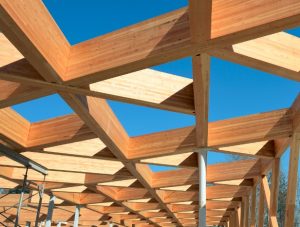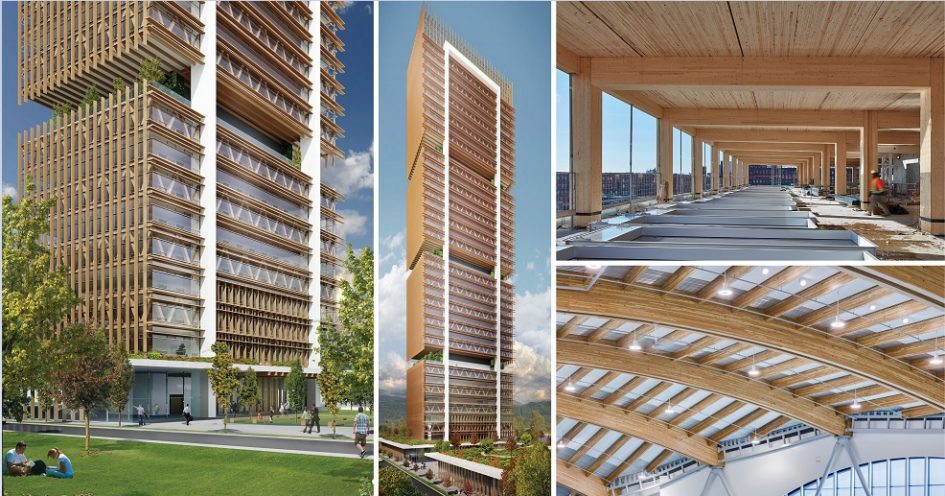When it comes to visual appeal in the built environment, mass timber is in a league of its own. A renewable building material with low embodied energy, wood is durable, versatile, and can add significantly to the value of a building over the long-term.
Once used modestly in high-rise construction, wood is increasingly becoming a primary material of choice, thanks to advancements in products and manufacturing. All across Canada building codes are changing to allow for taller structures made predominantly of mass timber, opening the way for some of the most innovative, beautiful structures our cities have ever known.
“As both a structural and decorative element, timber provides a warm and natural aesthetic unlike anything else on the market,” says Mark Ritchie, a Principal with RJC Engineers. “But the benefits of timber go beyond visual appeal. Research is showing human exposure to natural, organic materials like wood, has a calming effect and may play a significant role in our health and wellness. It is also the only renewable building material that is harvested from responsibly managed forests, making it an environmentally-conscious choice among builders.”

Architect: HCMA
According to Ritchie, a significant benefit of using timber is that unlike other construction materials (steel or concrete), timber stores significant amounts of carbon, preventing it from entering the atmosphere. “Building with timber also cuts emissions linked to steel and cement production, which is the second-largest industrial emitter in the world after the fossil fuel industry,” he says.
Renewability, durability and beauty aside, timber delivers numerous other benefits to occupants and builders alike. Whether it’s exposed heavy-wood structural components within an interior space, or a multi-storey building constructed entirely from mass timber, wood is a trend that’s here to stay, and here’s why:
- Wood is safe.
As building codes change to allow for 12-plus storeys in mass timber construction, many people remain skeptical about wood’s combustibility and potential threat as a fire hazard. Mass timber structures are designed for one- to two-hour fire events, much like steel or concrete structures. “A mass timber building will be designed to the same fire resistance as compared to concrete or steel structures. Not only will it meet current fire ratings, the volume of timber used make a mass timber structure difficult to ignite,” says Ritchie.
- Wood is cost-effective.
Abundant and readily available, wood is lighter than other materials allowing for a reduction in foundation costs.
- Wood is a great insulator.
Whether you live in a warm, damp climate or one that fluctuates season-to-season, wood is an excellent insulator with flexible thermal properties. Another advantage is that timber naturally buffers moisture without compromising integrity: “Timber has a low thermal conductivity (high insulating capacity) when compared with structural steel or concrete,” says Richie.
- Wood offers seismic resilience.
For builders and architects in Western Canada, seismic activity is a major concern. Wood is naturally flexible, and combined with the right connectors and structural elements, timber design can match the energy dissipation (joint flexibility) found in steel or concrete structures.
- Wood absorbs sound and is quiet during construction.
Designing an interior space that will maximize the occupant experience means considering how sound will move throughout the building. Wood can be formed to amplify and enhance sound—or mute it, if desired. “Mass timber sites are quiet during construction as the need for heavy structure equipment found with steel or concrete builder construction sites are not required,” says Ritchie.
As a leader in structural design, RJC has a long history of pursuing innovative uses of building materials, and the firm’s expertise in timber has placed it at the forefront of best practices and code development across Canada.
Find out more about the many ways to incorporate timber into your next project by contacting Mike Richie at mritchie@rjc.ca or visiting www.rjc.ca.







It’s really cool to know that timber these days can be as safe as steel or concrete when it comes to dealing with fire. It’s amazing how far we’ve come with building materials. I’ve been thinking of building my dream restaurant lately and I was wondering if timber would’ve been a safe material to use. I’m a big fan of the pictures you showed in your article where timber is used to accent the structure and I’m aiming for something similar. It’s nice to know that it’s safe and that I won’t have to worry about it igniting easily because of some kid’s prank or a tipped-over candle. I’ll be sure to contact a timber supplier to see if they can provide timber like that once I start building the restaurant of my dreams.
My uncle is looking to have a custom home built next to the woods that will be perfect for his future kids. He isn’t sure what kind of materials he wants it to be made of yet. I’ll let him know what you said about how a mass timber structure can be hard to ignite, and it can meet fire ratings. I think that he would be really happy if he would get some good timber from a professional to make his home with.
I really like how you stated that wood is actually a very good insulating material to work with. I want to do more outdoor landscaping projects, and I want something that can help me manage the noise and other factors we experience here at home. This material sounds perfect, so I’ll ask around for any landscape experts for timber supplies before I start working.